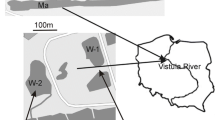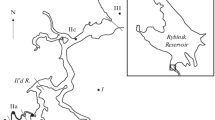Abstract
Several aspects of community organization wereanalyzed comparatively in a small side-arm of theParaná River (Correntoso) and a shallowfloodplain lake (El Tigre) (31° 41′ S and60° 42′ W), in relation to the hydrology of thesystem. Taxonomic and morphological composition inthe river differed from that in the lake: the riverhad lower species richness (151 vs 218),different contributions of some Classes to totalspecies number (higher Cyano-, Zygo- andDiatomophyceae vs higher Chlorophyceae), anddiffent proportions of nannoplanktonic algae (67.5%vs 80.7%) and netplanktonic filamentousspecies (18.2% vs 4.2%). Phytoplanktonbiomass, higher in the lake than in the river due tothe retention time, was mostly dominated bynannoplankton and netplankton. Loticphytoplankton was dominated by typical fluvialspecies of Diatomophyceae (R-strategists). Riverconditions seem to maintain a subclimacticcommunity, which was little impacted by the flushingof populations from floodplain lakes. Water levelwas the main factor controlling phytoplanktonbiomass, species diversity (H), evenness (E) andcommunity change rate (σ) in the river. Inthe lake, phytoplankton had an autogenicsuccessional sequence during the isolation phase (C-to S-strategists) and other responses todisturbance, mainly during the flood(R-strategists). Frequent changes in phytoplanktoncomposition, biomass, H, E and σ, revealed aenvironmental instability in the lake, which may beexplained by interactions of external factors(hydrology and climatology) and those of internalorigin, such as nutrients and grazing.
Similar content being viewed by others
References
Anselmi de Manavella, M. I. & M. O. García de Emiliani, 1995. Composición y dinámica del fitoplancton en una sección transversal del río Correntoso. Rev. As. Cienc. Nat. Litoral 26: 39-54.
Bonetto, A. A. & I. R. Wais, 1990. The Paraná River in the framework of modern paradigms of fluvial systems. Acta Limnol. Brasil. 3: 139-172.
Carbajal-Chitty, H., 1993. Some notes about the Intermediate Disturbance Hypothesis and its effects on the phytoplankton of the Middle Orinoco River. Hydrobiologia 249: 117-124.
del Giorgio, P. A., A. Vinocur, R. J. Lombardo & G. Tell, 1991. Progresive changes in the structure and dynamics of the phytoplankton community along a pollution gradient in a lowland river - a multivariate approach. Hydrobiologia 224: 129-154.
Descy, J-P., 1987. Phytoplankton composition and dynamics in the River Meuse (Belgium). Arch. Hydrobiol. Supp. 78: 225-245.
Descy, J.-P., C. S. Reynolds & J. Padisák (eds), 1994. Phytoplankton in turbid environments: Rivers and Shallow Lakes. Hydrobiologia 289, Kluwer Academic Publishers, Dordrecht, 214 pp.
Dias, C. Jr., 1990. Ciclo anual do fitoplâncton e algumas variáveis ambientais na Lagoa do Infernao (S.P.). Ms.Sc. Thesis, UFSCar, San Carlos (Brasil), 108 pp.
Drago, E., 1989. Morphological and hydrological characteristics of the floodplain ponds of theMiddle Paraná River (Argentina). Rev. Hydrobiol. trop. 22: 183-190.
García de Emiliani, M. O., 1979. Campaña Keratella I a lo largo del río Paraná Medio, III: Fitoplancton de ambientes leníticos. Rev. As. Cienc. Nat. Litoral 10: 73-84.
García de Emiliani, M. O., 1980. Fitoplancton de una laguna del valle aluvial del río Paraná ('Los Matadores'), Santa Fe, Argentina. I. Estructura y distribución en relación a factores ambientales. Ecología 4: 127-140.
García de Emiliani, M. O., 1981. Fitoplancton de los principales cauces y tributarios del valle aluvial del río Paraná: tramo Goya-Diamante, I. Rev. As. Cienc. Nat. Litoral 12: 112-125.
García de Emiliani, M. O., 1985. Fitoplancton de los principales cauces y tributarios del valle aluvial del río Paraná: tramo Goya-Diamante, III. Rev. As. Cienc. Nat. Litoral 16: 95-112.
García de Emiliani, M. O., 1990. Phytoplankton ecology of the middle Paraná River. Acta Limnol. Brasil. 3: 391-417.
García de Emiliani, M.O., 1993. Seasonal succession of phytoplankton in a lake of the Paraná River floodplain, Argentina. Hydrobiologia 264: 101-114.
García de Emiliani, M. O. & M. I. Anselmi de Manavella, 1983. Fitoplancton de los principales cauces y tributarios del valle aluvial del río Paraná: tramo GoyaDiamante, III. Rev. Asoc. Cienc. Nat. Litoral 14: 217-237.
Hamilton, S. K. & W. M. Jr. Lewis, 1987. Causes of seasonality in the chemistry of a lake on the Orinoco River floodplain, Venezuela. Limnol. Oceanogr. 32: 1277-1290.
Hamilton, S. K. & W. M. Jr. Lewis, 1990. Basin morphology in relation to chemical and ecological characteristics of lakes on the Orinoco River floodplain, Venezuela. Arch. Hydrobiol. 119: 393-425.
Harris, G. P., B. B. Piccinin & J. Van Ryn, 1983. Physical variability and phytoplankton communities. 5. Cell size, niche diversification and the role of competition. Arch. Hydrobiol. 98: 215-239.
Huszar, V. L.M., 1994. Fitoplâncton de um lago amazônico impactado por rejeito de bauxita (Lago Batata, Pará, Brasil): Estructura da comunidade, fluctuacoes espaciais e temporais. Ph. D. thesis, PPGERN, UFSCar, Sao Carlos (Brasil), 328 pp.
Iltis, A., 1977. Phytoplankton populations of the lake Chad. I. Normal lake Chad stage (February, 1971 and January, 1972). Cah. O.R.S.T.O.M., ser. Hydrobiol. 11: 33-52.
Izaguirre, I. & A. Vinocur, 1994. Algal assemblages from shallow lakes of the Salado River Basin (Argentina). Hydrobiologia 294: 57-64.
Jones, J. G., 1979. A guide to methods for estimating microbial numbers and biomass in freshwater. Scient. Publs. Freshwat. biol. Ass. 39: 1-107.
Junk, W. J., P. B. Bayley & R. E. Sparks, 1989. The flood pulse concept in river-floodplain systems. In Dodge, D. P. (ed.), Proceedings of the International Large River Symposium. Can. Spec. Publ. Fish. aquat. Sci. 106: 110-127.
Kalff, J. & S. Watson, 1986. Phytoplankton and its dynamics in two tropical lakes: a tropical and temperate zone comparison. Hydrobiologia 138: 161-176.
Lewis, W. M. Jr., 1976. Surface/volume ratio: implications for phytoplankton morphology. Science 192: 885-887.
Lewis, W. M. Jr., 1978. Analysis of succession in a tropical phytoplankton community and a new measure of succession rate. Am. Nat. 112: 401-414.
Lewis, W. M. Jr., 1983. A revised classification of lakes based on mixing. Can. J. Fish. aquat. Sci 40: 1779-1787.
Melack, J. M. & T. R. Fisher, 1990. Comparative limnology of tropical floodplain lakes with an emphasis on the central Amazon. Acta Limnol. Brasil. 3: 1-48.
Moss, B.& H. Balls, 1989. Phytoplankton distribution in a floodplain lake and river system. II. Seasonal changes in the phytoplankton communities and their control by hydrology and nutrient disponibility. J. Plankton Res. 11: 839-867.
Munawar, M. & I. F. Munawar, 1986. The seasonality of phytoplankton in the North American Great Lakes, a comparative synthesis. Hydrobiologia 138: 85-115.
O'Farrel, I., 1994. Comparative analysis of the phytoplankton of fifteen lowland fluvial systems of the River Plate Basin (Argentina). Hydrobiologia 289: 109-117.
Padisák, J., 1992. Seasonal succession of phytoplankton in a large shallow lake (Balaton,Hungary) - a dynamic approach to ecological memory, its possible role and mechanisms. J. Ecol. 80: 217-230.
Reynolds, C. S., 1980. Phytoplankton assemblages and their periodicity in stratifying lake systems. Holoart. Ecol. 3: 141-159.
Reynolds, C. S., 1984. The ecology of freshwater phytoplankton. Cambridge Univ. Press, London: 384 pp.
Reynolds, C. S., 1988. Functional morphology and the adaptative strategies of freshwater phytoplankton. In Sandgren, C. D. (ed.), Growth and Reproductive Strategies of Freshwater Phytoplankton. Cambridge University Press, Cambridge: 388-434.
Reynolds, C. S., 1993. Scales of disturbance and their role in plankton ecology. Hydrobiologia 249: 157-171.
Reynolds, C. S., J.-P. Descy & J. Padisák, 1994. Are phytoplankton dynamics in rivers so different from those in shallow lakes? Hydrobiologia 294: 1-7.
Rojo, C. & M. Alvarez Cobelas, 1993. Hypertrophic phytoplankton and the Intermediate Disturbance Hypothesis. Hydrobiologia 249: 43-57.
Rojo, C., M. Alvarez Cobelas & M. Arauzo, 1994. An elementary, structural analysis of river phytoplankton. Hydrobiologia 289: 43-55.
Schiaffino, M., 1977. Fitoplancton del río Paraná. I. Sus variaciones en relación al ciclo hidrológico en cauces secundarios de la llanura aluvial. Physis 36: 115-125.
Shannon, C. E. & W. Weaver, 1963. The Mathematical Theory of Communication. Univ. Illinois Press, Urbana, 117 pp.
Sommer, U., 1989. The role of competition for resources in phytoplankton succession. - In Sommer, U. (ed.), Plankton ecology, succession in plankton communities. Springer, Berlin: 57-106.
Uherkovich, G., 1984. Phytoplankton. In Sioli, H. (ed.), The Amazon: Limnology and Landscape Ecology of a Mighty Tropical River and its Basin. Dr W. Junk. Publ., Dordrecht: 295-310.
Uherkovich, G. & H. Rai, 1979. Algen aus dem Rio Negro und seinen Nebenflüssen. Amazoniana 6: 611-638.
Utermöhl, H, 1958. Zur Vervollkommnung der quantitativen PhytoplanktonMethodik. Mitt. int. Ver. Limnol. 9: 1-38.
Van den Brink, F. H. B., M. M. Van Katwijk & G. Van der Velde, 1994. Impact of hydrology on phyto-and zooplankton community composition in floodplain lakes along the Lower Rhine and Meuse. J. Plankton Res. 16: 351-373.
Watson, S. & J. Kalff, 1981. Relationships between nannoplankton and lake trophic status. Can. J. Fish. aquat. Sci. 38: 960-969.
Welcomme, R. L., 1985. River fisheries. FAO Fish. Tech. Pap., 262: 330 pp.
Zalocar de Domitrovic, Y., 1992. Fitoplancton de ambientes inundables del río Paraná (Argentina). Rev. Hydrobiol. trop. 25: 177- 188.
Zalocar de Domitrovic, Y., 1993. Fitoplancton de una laguna vegetada por Eichhornia crassipesen el valle de inundación del río Paraná (Argentina). Ambiente subtropical 3: 39-67.
Author information
Authors and Affiliations
Rights and permissions
About this article
Cite this article
García de Emiliani, M.O. Effects of water level fluctuations on phytoplankton in a river-floodplain lake system (Paraná River, Argentina). Hydrobiologia 357, 1–15 (1997). https://doi.org/10.1023/A:1003149514670
Issue Date:
DOI: https://doi.org/10.1023/A:1003149514670




